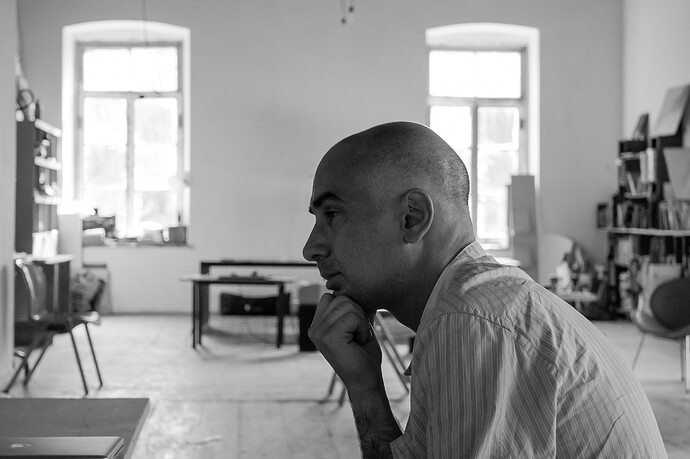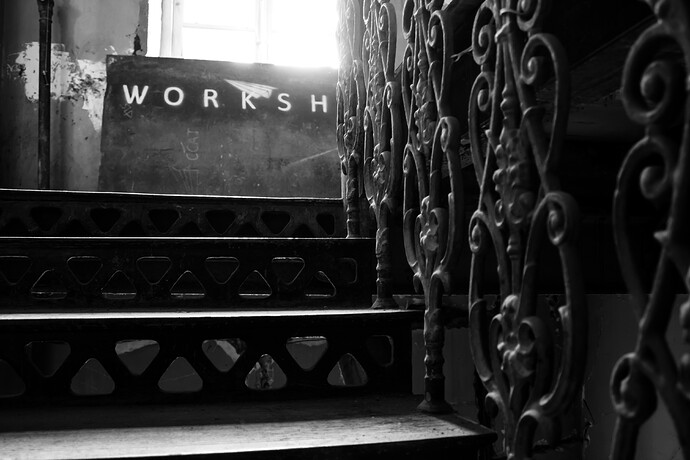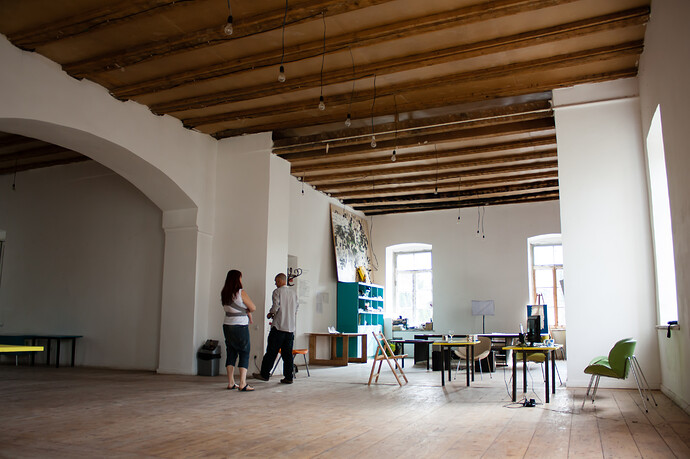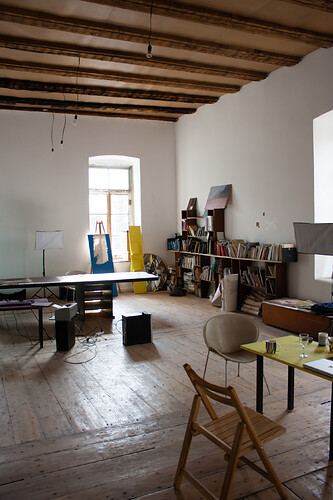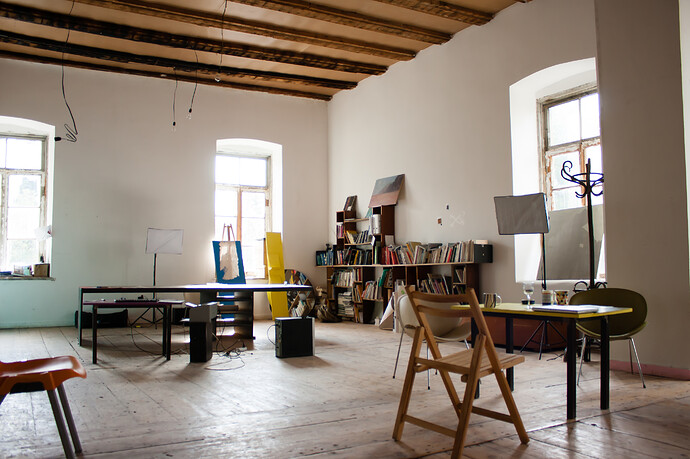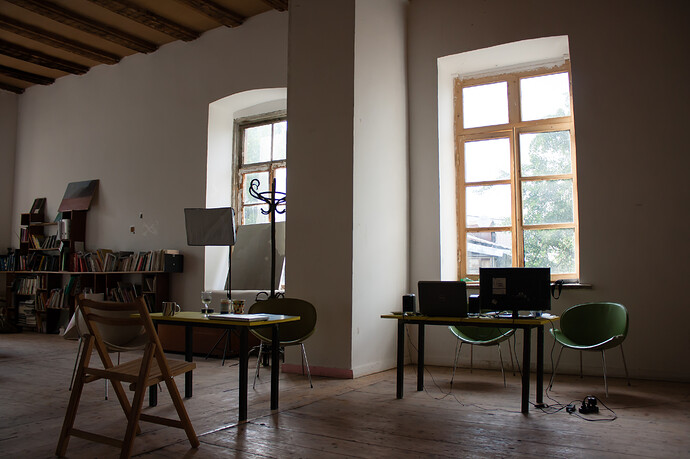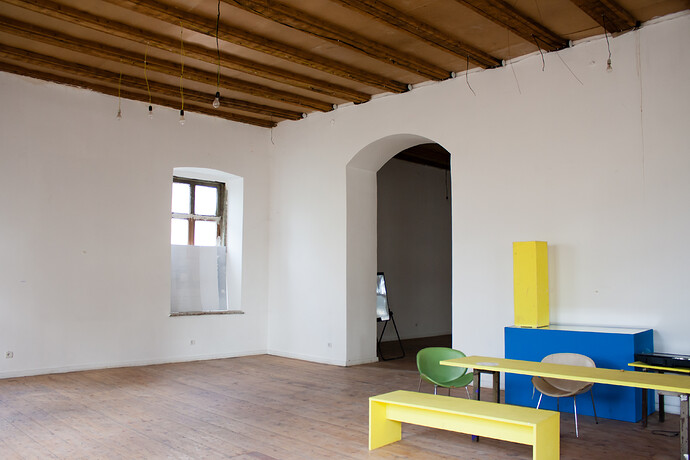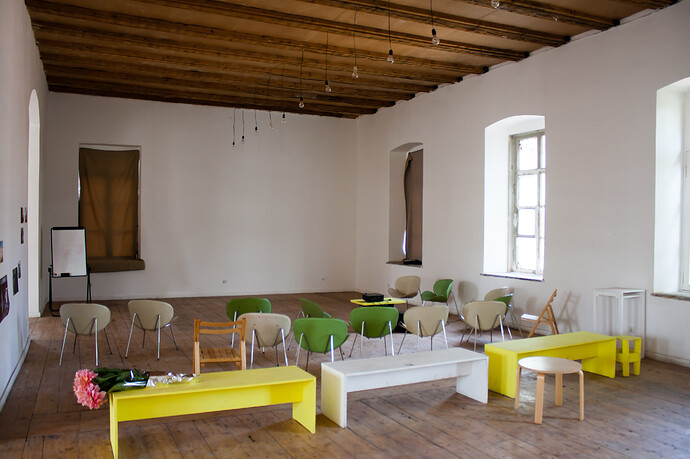When people ask me: “why did you start it? what was the trigger?”.
I say, the trigger was frustration.
About 8 years ago, I met Wato in an old bunker. It was a Friday night. Loud electronic music came out of the speakers, a surrealistic video played on the wall. The Georgians here looked quite different from the people I saw on the streets. I felt like I was in an underground club in Berlin, or New York. But no, it was Tbilisi. And this was one of Wato’s projects.
Wato is an artist, and has been actively trying to change the world around him. In 2009 he founded the Center of Contemporary Art (CCA) in Tbilisi, the first of its kind. Last year, when Edgeryders came to town for the first time, I was hoping to organize the international conference at CCA. Because we speak the same language. Because at CCA, they use artistic mechanisms to tackle social issues: they collaborate with a biological farming organization, they stepped away from traditional education and offer an informal master’s degree, and they research self organizational systems in Georgia before communism came and destroyed the practice.
Wato and I met at CCA, on possibly one of Tbilisi’s hottest summer days. Hidden in a courtyard with large factory-like buildings, the center is not easy to find. Only a small sign on the door gives away what the building hosts. The staircase is old and untouched, the details tell stories.
It is quite a surprise when you walk all the way up the stairs and enter CCA’s space.
Wato explains me that CCA's core direction is education. They have an independent study program for 9 months, an informal master program. It's near masters level, but they don't have a license, no accreditation.
In Georgia if you have more than 9 months education program you need to have a license. And a license means that you are controlled by the state basically, and that you can’t do many experiments. Because it is difficult to articulate this.
So we found this niche to have a program less than 9 months. It is a new type of profile, which we offer, and this profile is something hybrid between artistic practice and being a producer.
Here students are doing different artistic disciplines, starting from cartography, video, installations, and more.
Students also do social studies, where they contact closed circle societies, which are closed in their own area and not really interact with the world around. We want the students to individually go inside these societies and invite people from there to be part of a project. And invite other artists, to form a group, on an equal level of creativity. And together with socially disadvantaged people and artists, realize different projects.
The educational program is very successful, Wato tells me.
Now it’s vacation, but generally it’s very busy with students. We have now 20 students. So it has been growing and we have more and more people who want to be part of this study program. Also, because they see that people from here, when they finish their studies, they really get connected to the art world, not the commercial art world, but the institutional art world. They get residencies, for example.
One of their alumni, Ana Chaduneli, is in Zurich for 4 months, she won the Tsinandali art price, was in Norway, in Nice in France, and currently is invited to participate in the Istanbul and Kyiv Biennial. There are others as well, for example Giorgi Magradze, who is traveling around Germany at the moment.
Wato taught at the state academy of art when he realized it was not working, that is when he founded CCA. He tells me about the differences he sees between art academy students and the students at CCA.
Two years ago, the final show of our students took place in Villa Arson in Nice, a very prestigious art school and gallery. Art academy students could not dream of it.
We don’t have accreditation and we don’t give diplomas, but for us it is still possible to do such kind of large scale exchanges, with academic institutions in Europe.
Another example is also quite telling, I think:
There were six artists invited to France, chosen by an international jury. Five of them were our alumni and one was from the art academy. I mean, if you compare, the art academy has thousands of students and more than a 3 million GEL budget. We have 20 students and a 70.000 GEL budget per year. These are numbers, but I think they speak for themselves. It means something, right?
But education is not all CCA is involved in. They have been working on agriculture for several years already, which they call Artistic Thinking in Relation to Organic Culture.
It’s about implementation of artistic practice inside other fields of our life. In Artistic Thinking in Relation to Organic Culture, we talk about everything related to farming: composting, cooking, anything related to nature basically, the environment.
We collaborate very strongly with NGO Elkana, it’s a bio farming association, for years already we work with them. This is a core part of our work.
It is natural, if you look at art. Art thematically can cover everything, it can be about psychology, it can be about family, it can be about nature, it can be about architecture, it can be about war, it can be about everything, refugees, immigration.
It means that art has, in fact, the potential to generate some position towards anything in the world.
You know, art is always about enlarging the borders of what art was before. We have this term called relational aesthetics. If you don’t know you it, should read it: there is a book called Relational Aesthetics by art theoretician Nicolas Bourriaud. It is seen as one of the most important books after the second world war. Relational aesthetics means, that art work is not necessary something that you produce and hang on the wall, but it can be a situation. It can be a social setting, it can be some kind of niche you find in the society, it can be a construction. I call it social architectures, some kind of opportunities and possibilities to be among the different social layers.
And art is kind of a mode of thinking. Basically. A mode of producing. Other people use only rational thinking mostly, artists are trained to use accident, mistake, contradiction, intuition. So artists have different modes of arriving to a result, from different ways, and everybody has it, you know. But artists are professionally trained to cultivate all these different skills, so that’s why they can also have different solutions, or different ideas about anything in our society, in the world.
As a result, CCA collaborates with several different organizations, both in and outside of Georgia.
We work with the Betlemi Information Office, which is ICOMOS representation. We work also closely with people in psychiatry, there is an institution called Georgian Center for Rehabilitation of Torture Victims, we have been doing shows together.
Wato is interested in giving artists in Georgia a frame of reference. That is why they organize exchange programs, and that is why they also want to explore what history teaches us. Communism destroyed systems of self organization, it also rewrote art history. Both are detrimental in building an artists self-esteem. Because if someone else from Georgia could be a part of large international art movements, if someone else from Georgia could built a theater together with their peers, than why can't you?
Most important artists and tendencies were not accepted by the communist regime, they were killed or deported, they did not become part of art history basically. So now we don’t have really art history that is reflecting real processes going on in the 20th century.
We have a project to make a book about 20th century art history. We have divided it into 6 different chapters, the 20th century, the communist times. The first chapter was published already, about the end of the 19th century, before modernism. Now we got funding from the ministry of culture and Soros foundation to do modernism, which will be a very large issue. Bilingual, in English and Georgian. And so we will make 6 publications, which will become six chapters of the book.
Self-organization systems seem a large theme at CCA today. And rightly so.
Our students formed The New Collective, maybe you’ve heard of these girls. Eleven girls. They participated in a workshop by Nina Henrickson, a swedish artist, on self-organization, And after the two week workshop, the eleven girls, the participants, decided to form an association. We supported them with a small fee for the foundation, and now they are already really well known. They were invited to Manchester to open a festival. They didn’t get visa though, but they work now on this issue of migration.
Also, in October starts the second edition of Tbilisi Triennial, which we organize. The name of it is S.O.S.: Self -Organized – Systems.
It is about mechanisms and tools of self-organization.
We identified three: agricultural, village community, how is it self organized? Another is about professional unions, like guilds. And the third is the self organization around a common interest.
For example in Kakheti, in kvemo machkhani, we found a theater. It was build in the 19th century, by just the will of the people in the village, everybody, farmers, aristocrats, united their energy. They wanted to have a theater, and they build a theater. It is still standing now, quite intact, a European style theater. It is absolutely a unique case.
We got money from Soros foundation and the community development foundation to research and publish a book. About ten cases of self-organization before the communist regime.
It is very strange that nobody else has researched this idea before. Of how Georgian, or any post soviet countries, had these systems of self-organization before communism.
And that is the reason Wato started CCA.
When people ask me, why did you start it, what was the trigger, I say the trigger was frustration. Because I was working in the art academy, the state art academy, and I saw how this institution is anachronistic. And instead of developing people, they are mutating people.
Because their programming is really beyond any context, there aren’t any contextualized curricula and strategies.
I started this in 2010, I was still working at the art academy.
And I observed how our students here were literally flying to other places, to show their work and resonate outside of their homes in Tbilisi. And art academy students were standing still in one place.
Basically, on one hand it was a lack of relevant art education, on the other hand there was no platform of contemporary art. Because, before if you would come to Georgia, and you were interested in contemporary art, you would arrive into some artists kitchen or privately. And there was no place where you could come and connect. A platform, use it, or work with it, or get some advice or support.
So this is like, a station I like to say, for contemporary art, which works in many many ways.
I must say one thing, that from my kind of temperament and my education, I am an artist myself. If you are once artist, you can not change.
What I do now with any kind of work I do, like administration or organization, still somehow, everywhere I seek creativity, it is all the result of creativity.
If you ask me: “what is CCA for you?” my answer will be that it is an artistic work. Because we invent things. We invent a new profile for studying. We invent artistic farming. We have other things we invent, social settings, like having a school without credits and without points and without exams.
It is how you kind of create and balance social settings. In this case about knowledge production and knowledge transfer.
Of course, most boring is to deal with project proposals and reporting, but it’s also not so heavy that you would say I can’t do it.
And what I mostly enjoy is, that when the students make a first exhibition, and I enter the space and I feel a good atmosphere, this is the most, biggest, I don’t know how to say, happiness.
Because it is a compliment. Because when we know that our students get scholarships, get residencies, then we know it makes sense what we do. It is not like we spend energy and it is for nothing. So that is feedback from their side.
Also, when we have exhibitions and people are coming and visiting and staying. You know, sometimes, everything is finished, three hours past, but people wont go away. Because they feel good here, this is also a compliment. The atmosphere is in a way that is magnetizing people to be here.
CCA is lucky to be funded for three years by the Deutscher Volkshochschul-Verband (DVV) for their informal master, as it as a core maintains the whole institution.
Besides DVV, we are project based funded. Now the ministry of culture is also changing their strategy, they will have program funding. This means that you can propose one year in advance, and you can get funding for this program, and you execute this program later.
We also don’t pay rent for the space, which is a very important starting point. We work with the museum of medicine history and we develop this museum. We bring so much input in the museum that it would be much more if we would just pay rent. This is a win-win situation, where our creativity and our experience is used for the development of the museum. And we get space in exchange for it.
The daily practices at CCA are also mostly focused around the educational part, but not only.
Usually, on a daily bases, there are 4 hours a day different lectures. We have many artists and people from theory and history which are rotating, in blocks, 8 lectures, 4 lectures, sometimes 1, masterclasses, workshops.
We work also weekly, we have meetings. Today we had a meeting about the triennial.
But it is very informal, everything. It’s very important to keep a balance between informality and responsibilities, because you can totally loose your community if you’re not careful. We also have the understanding we have responsibilities, we have to keep things going, it needs effort.
I think that most important is that people coming here feel themselves well. Many young artists, young students, come from different milieus. The come here and they feel as if they are elsewhere, being in another space you know. And they feel well.
And what support, besides money, could CCA use?
Money, it has never been a sensory point for us to work. Very important, what we would really need, is to get a good structure, get a better structure.
I think what we have to learn from the western world, Georgians and other post soviet people, is how to work in a structure. How to be more efficient with a structure. Because that’s why there’s a structure, to make things effective, to make things efficient.
Another thing is of course that we could use more international partnerships. We have a lot of international partners. I mean, if somebody is tells me ‘I will contact you and you will have new contacts’, I am not sure.
We have many contacts, I mean.
But most important I think is to have partners which you personally know and which really have interest to work with you.
Eastern European countries – except Poland maybe – look to the west, so they are not so much interested in the East of them.
In our case we are interested in, 360 degrees, everywhere around us. Because I think it is stupid to just look 1 degree.
For example, CCA is part of the Asian Art Network, it took place in Korea where I was invited to represent CCA. It was very interesting to work with partners from Iran, India, China. These world are very interesting.
So, I think that the most crucial for us would be on the one hand structural advices, development, and on the other hand also to have opportunity for younger colleagues to have short internships, to visit other institutions where they can learn from practice, how things work. I think those two things are the most important.
And what can CCA offer?
We are very open.
What we can offer. We can offer residencies, we can offer a change of opportunities, we can offer exhibition practice, anything which is relevant.
What we can offer, also, is that we can have interns here, for example. We have one girl here now from Paris, from Sorbonne, studying museum studies. She’s for two months on internship here. She’s doing many different things for us, and for the museum of medicine history, which we are cooperating with.
I get really hundreds of emails, unpaid, where I just suggest people whom to meet, where to go, what to visit, finally I maybe not even meet these people, But I work to kind of coordinate and help them find the right things for them. It is also like a service in a way.
From our talk it is very clear that CCA works both internationally and domestically together with several different partners. So what does it mean to them?
Pooling resources is very important, I think in general human resources is the most important problem in our part of the world. Because there are not many people which have, on one hand, the awareness of contemporary culture and, on the other hand, skills to operate in it, and be relevant in it. So, to kind of find the right resources together, it is crucial. You can’t make a one man show.
Mutual support is solidarity, in which different institutional bodies, different personalities, have solidarity for each other. When they need support and help each other. Or work together in a way, or having the same aim, standing next to each other.
Collaboration is something more than all this. Collaboration is when already things are happening in a kind of synergy. Different skills, different talents, different resources, of people and institutions, are really very closely connected to each other and serving each other.
Wato and CCA are here to stay for the long run, to change society step by step.And do it his way.
I was invited to speak at Ted talk, and I refused in the end, because they said “oh, this is not so TED-ish” or “This needs to be more TED-ish”, ok, I mean, for what should I do it. And they said: “For prestige”. And so I refused to take part. I would have done it if they’d allowed me to do it in a way I wanted.
I don’t go away from Georgia. I’ve been away and returned 1999. And since then I work here. I studied from 1994 till 1998, and I worked one year for Belgian television. And then I returned. I never had the idea to stay.
I think it is very important to live here. Because there are so many things that need to be done. And I don’t find it so difficult.
Photos by George Surguladze
